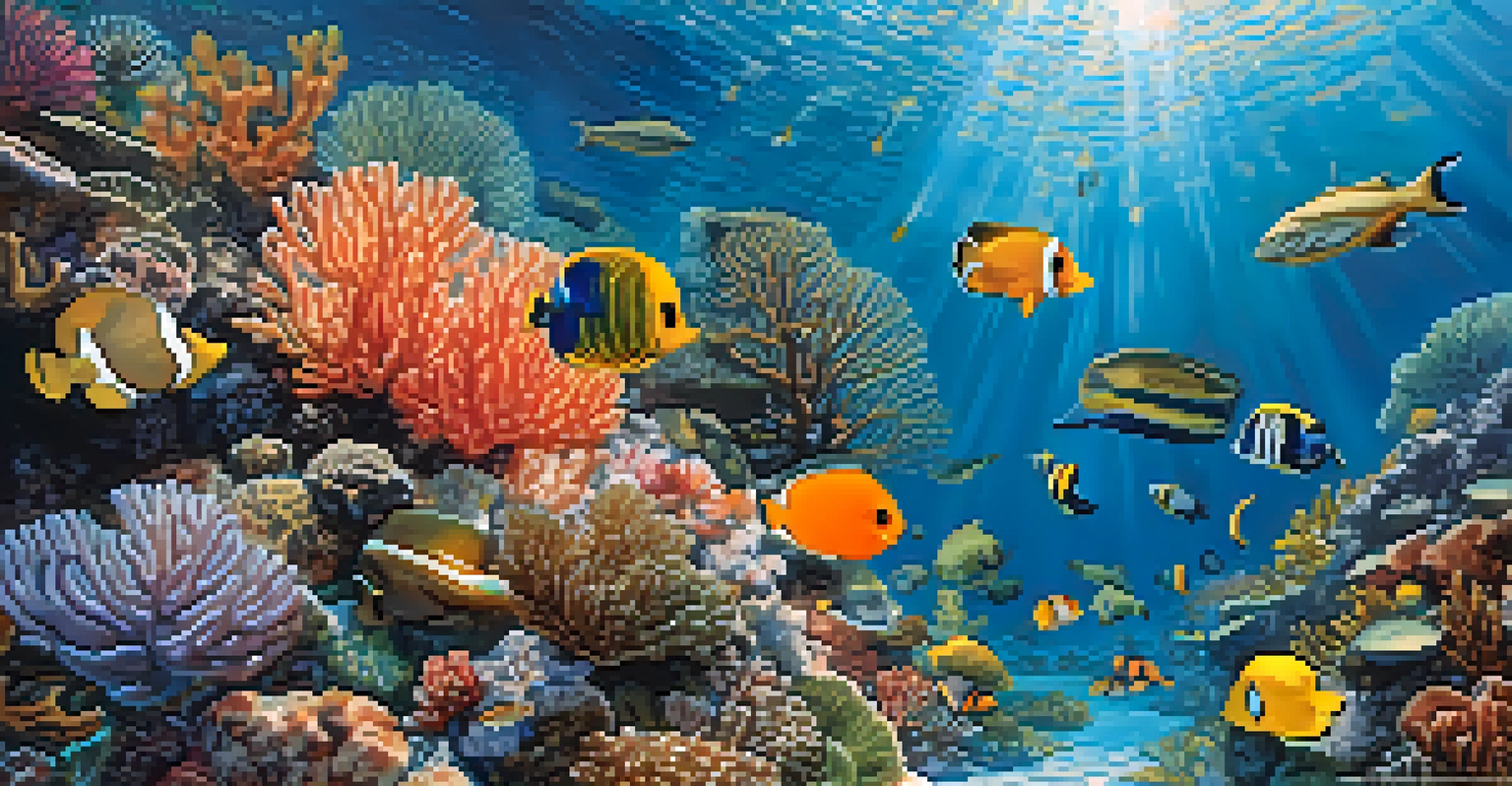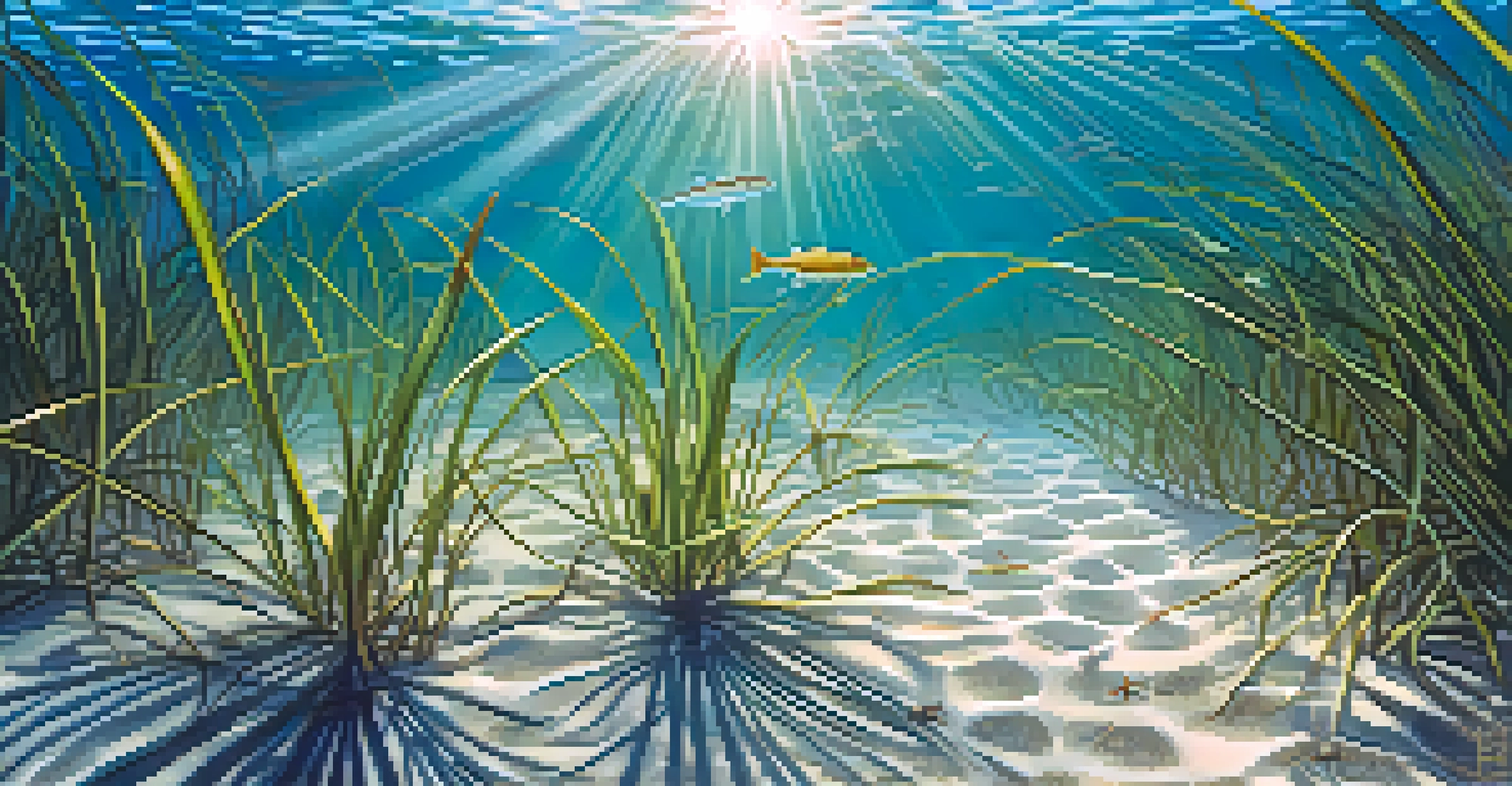Climate Change Effects on Florida's Coastal Ecosystems Explained

Overview of Florida's Coastal Ecosystems
Florida's coastal ecosystems, including mangroves, coral reefs, and seagrasses, are vital to both wildlife and human communities. These areas act as natural barriers against storms, support diverse marine life, and contribute to the state's economy through tourism and fishing. Understanding the intricate balance of these ecosystems helps highlight their importance in the face of climate change.
The environment is where we all meet; where we all have a mutual interest; it is the one thing all of us share.
Each ecosystem plays a unique role: mangroves prevent erosion, coral reefs provide habitat, and seagrasses improve water quality. However, the health of these ecosystems is increasingly under threat as climate change accelerates. It's crucial to recognize how interconnected these systems are and the potential ripple effects of their decline.
As we delve deeper into the effects of climate change on these habitats, it's essential to grasp the challenges they face. Rising sea levels, ocean acidification, and increased storm intensity are just a few factors contributing to their vulnerability. Let's explore how these threats specifically impact Florida's coastal ecosystems.
Rising Sea Levels and Their Impact
One of the most pressing issues caused by climate change is rising sea levels, which can dramatically affect Florida's coastlines. As glaciers and ice sheets melt and water expands from warming temperatures, the encroaching seas threaten both natural habitats and human settlements. Coastal habitats like mangroves and salt marshes are particularly vulnerable, as they require specific salinity and tidal conditions to thrive.

These ecosystems serve as crucial buffers against storm surges and erosion, but with rising sea levels, their ability to function declines. The loss of these protective barriers can lead to increased flooding in coastal communities, putting lives and property at risk. Additionally, this displacement can disrupt local wildlife that relies on these habitats for shelter and food.
Climate Change Threatens Ecosystems
Florida's coastal ecosystems face severe threats from climate change, including rising sea levels, ocean acidification, and increased storm intensity.
Furthermore, as sea levels rise, saltwater intrusion into freshwater systems can alter the ecological balance, affecting plant and animal species. This shift can lead to a decline in biodiversity, making it harder for some species to survive. Understanding these dynamics is key to developing effective conservation strategies.
Ocean Acidification's Effects on Marine Life
Ocean acidification is another significant consequence of climate change, resulting from increased carbon dioxide levels in the atmosphere. When CO2 is absorbed by the oceans, it lowers the pH of the water, creating more acidic conditions. This phenomenon poses a serious threat to marine ecosystems, particularly coral reefs, which rely on calcium carbonate to build their structures.
We won’t have a society if we destroy the environment.
Coral reefs are often referred to as the 'rainforests of the sea,' providing vital habitat for countless marine species. However, as ocean acidification progresses, coral bleaching becomes more frequent, weakening these underwater ecosystems. The loss of coral not only impacts marine life but also affects tourism and fisheries that depend on healthy reefs.
Moreover, ocean acidification can disrupt the food web, impacting shellfish and other marine organisms that struggle to adapt. As these foundational species decline, the effects ripple through the ecosystem, ultimately threatening the livelihoods of coastal communities. Understanding ocean acidification is crucial for preserving Florida's coastal ecosystems.
Increased Storm Intensity and Frequency
Climate change is linked to an increase in the frequency and intensity of storms, which poses a significant threat to Florida's coastal ecosystems. Warmer ocean temperatures fuel more powerful hurricanes and tropical storms, leading to devastating impacts on both natural and human environments. These storms can cause extensive damage to habitats like mangroves and coral reefs.
During storms, strong winds and storm surges can uproot vegetation, erode shorelines, and damage coral structures. The physical destruction of these ecosystems diminishes their ability to protect coastlines from future storms, creating a vicious cycle of vulnerability. Additionally, the sediment and pollutants washed into coastal waters can further degrade water quality, harming marine life.
Impact on Wildlife and Biodiversity
The rapid changes in coastal habitats disrupt wildlife and threaten biodiversity, as species struggle to adapt to new environmental conditions.
Communities must prepare for these impacts by investing in restoration and protection efforts for these vital ecosystems. Building resilient coastal habitats can mitigate storm damage and support biodiversity. Understanding the link between climate change and storm intensity is essential for developing effective strategies to safeguard Florida's coast.
Impact on Biodiversity and Wildlife Habitats
Climate change poses a significant threat to the biodiversity of Florida's coastal ecosystems, as species struggle to adapt to rapidly changing conditions. Many animals and plants are sensitive to temperature and salinity changes, which can disrupt their habitats and migration patterns. This shift puts stress on wildlife populations and can lead to declines in certain species.
For example, sea turtles, which rely on specific nesting sites along the beaches, may find their habitats altered by rising sea levels and increased storm activity. Similarly, fish species that depend on healthy coral reefs for breeding and feeding may face challenges as these vital habitats degrade. The loss of biodiversity can have cascading effects on the entire ecosystem.
Conservation efforts are critical to mitigate these impacts, focusing on protecting habitats and promoting species resilience. Engaging local communities in restoration projects can help ensure the survival of these vital ecosystems. Understanding the importance of biodiversity in maintaining ecosystem health is essential for Florida's future.
Economic Consequences for Coastal Communities
The effects of climate change on Florida's coastal ecosystems extend beyond environmental concerns; they also pose significant economic challenges. Coastal communities rely heavily on tourism and fishing industries, both of which are threatened by the degradation of natural habitats. As ecosystems decline, the appeal of Florida's beaches and marine life diminishes, impacting local economies.
For instance, coral reefs attract millions of visitors each year for snorkeling and diving, providing jobs and revenue to local businesses. However, as these reefs suffer from bleaching and damage, the tourism sector may experience declines. Similarly, fisheries could suffer as fish populations dwindle, leading to economic instability for those who rely on fishing as their primary source of income.
Economic Risks for Coastal Communities
The degradation of coastal ecosystems not only harms the environment but also poses significant economic challenges for communities dependent on tourism and fishing.
Addressing these economic consequences requires a proactive approach to conservation and sustainable practices. By investing in the protection and restoration of coastal ecosystems, communities can safeguard their livelihoods while preserving the natural beauty that attracts visitors. Understanding the economic implications of climate change is vital for creating resilient coastal communities.
Community Involvement and Conservation Efforts
Community involvement is essential for addressing the impacts of climate change on Florida's coastal ecosystems. Local residents, organizations, and policymakers can work together to foster awareness and implement conservation strategies. Engaging the community in restoration projects ensures that everyone has a stake in protecting these vital habitats.
Educational programs can empower individuals to make informed decisions about environmental stewardship. By raising awareness about the importance of coastal ecosystems, communities can cultivate a sense of responsibility and motivate action. Volunteering for beach clean-ups, participating in habitat restoration, or advocating for sustainable practices can all contribute to positive change.

Collaboration among stakeholders, including government agencies and nonprofits, can amplify conservation efforts. Together, they can develop policies that prioritize ecosystem health and resilience. Involvement at the community level is a powerful tool in the fight against climate change, ensuring that Florida's coastal ecosystems are preserved for future generations.